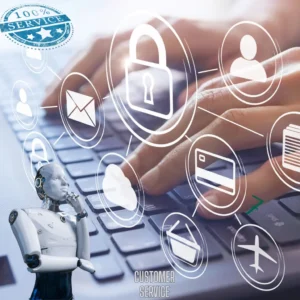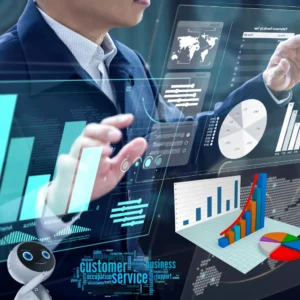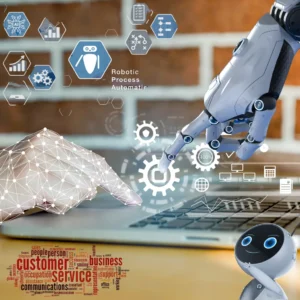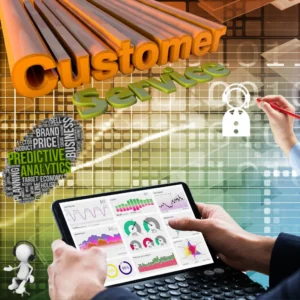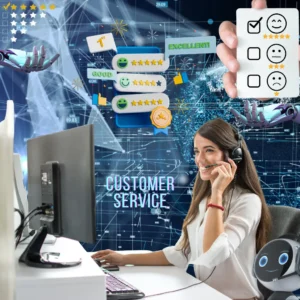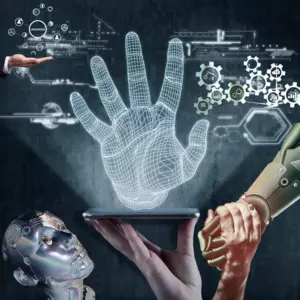
Revolutionizing Service Excellence
Unleashing the Power of Customer Service Tools for Continuous Learning and Improvement
In customer service, organizations striving for excellence recognize the indispensable role of continuous learning and improvement. Advanced technologies have created a new era where Customer Service Tools are pivotal in shaping operational strategies, enabling continuous learning and improvement.
Focused on automating processes and harnessing the power of AI, these tools encompass a spectrum of functionalities, from personalized training systems to real-time A/B testing platforms.
This discussion delves into the essential aspects of building and implementing such tools, emphasizing the requisite business and software knowledge, hardware infrastructure, training protocols, integrations, and the comparative landscape.
As companies navigate the evolving demands of customer service, adopting these tools emerges as a strategic imperative. They foster adaptability, innovation, and a customer-centric approach to pursuing operational excellence.
Table of Contents

Arindam Roy
An Automation Consultant with 25+ years of IT Experience
5 Continuous Learning and Improvement Tool ideas for the Customer Service
Customer Service Tools for Continuous Learning and Improvement:
1. AI-powered training and onboarding system:
This tool leverages machine learning to revolutionize the training and onboarding processes within the customer service domain. The system tailors training materials to each employee by analyzing individual performance data, ensuring a personalized and efficient learning experience. As employees progress, the system adapts the training program dynamically, optimizing it based on real-time performance metrics.
2. Feedback loop for model improvement:
Establishing a robust feedback loop is crucial for refining and enhancing AI models over time. This tool systematically collects user feedback on the performance of the AI systems, incorporating valuable insights into the continuous learning process. This iterative feedback loop ensures that the models evolve to meet the requirements and problems of the customer service landscape.
3. Continuous learning algorithms for evolving customer needs:
These machine learning algorithms are designed to adapt proactively to shifting customer preferences and market trends. By continuously analyzing data, these algorithms identify emerging patterns, enabling the customer service system to stay ahead of evolving customer needs. This tool ensures that the company remains agile and responsive to changes in the market, delivering a customer-centric approach at all times.
4. Automated performance analysis and improvement suggestions:
This tool utilizes AI to automate the analysis of performance metrics across the customer service domain. It provides actionable insights and suggestions for improvement based on the study of real-time data. By automating this process, the tool empowers employees to enhance their performance, contributing to overall customer satisfaction and operational excellence.
5. AI-driven A/B testing for customer service strategies:
This tool implements sophisticated A/B testing using AI algorithms to experiment with and optimize customer service strategies in real-time. The system identifies the most effective techniques for specific scenarios by continuously testing different approaches and variations. This dynamic optimization ensures that customer service strategies are efficient and adaptable to changing circumstances, thereby maintaining the company’s market leader position.
The “Customer Service Tools for Continuous Learning and Improvement” suite integrates AI technologies to personalize training, refine models through feedback, adapt to evolving customer needs, automate performance analysis, and optimize strategies through real-time experimentation. This comprehensive approach ensures that the company remains at the forefront of the customer service domain by embracing innovation and continuously improving its operations.
AI-powered training and onboarding system
Business Knowledge Required:
- Training Needs Analysis: Understanding the training needs and performance metrics relevant to customer service roles.
- Employee Performance Metrics: Knowledge of key performance indicators (KPIs) and metrics used to assess individual and team performance.
- Learning Path Personalization: Expertise in designing personalized learning paths based on employee roles, strengths, and areas needing improvement.
Software Knowledge Needed:
- Machine Learning Algorithms: Proficiency in machine learning algorithms for predicting individual learning patterns and adapting training content accordingly.
- Personalization Engines: Knowledge of personalization engines to dynamically adjust training materials based on real-time performance data.
- LMS Integration: Integration with Learning Management Systems (LMS) to streamline content delivery, tracking, and reporting.
Hardware Needed to Run the Tools:
- Cloud Infrastructure: Adequate cloud computing resources to handle the computational demands of machine learning algorithms and real-time personalization.
- Scalable Storage: Scalable storage solutions for housing diverse training materials and performance data.
Training Required to Run These Tools Once Created:
- ML Model Maintenance: Training for data scientists and engineers on maintaining and updating machine learning models based on evolving performance data.
- Administrator Training: Instruction for system administrators responsible for managing user access, content updates, and system configurations.
Integrations Necessary:
- HR Systems: Integration with HR systems for seamless onboarding and access to employee profiles.
- Performance Analytics Tools: Integration with analytics tools to gather insights into training effectiveness and individual performance.
Comparative Tools Already Available in the Market:
- Adaptive Learning Platforms: Platforms like Coursera for Business or Degreed that offer adaptive learning experiences.
- LMS with AI Features: Learning Management Systems with AI-driven features like TalentLMS or Docebo.
Recommendation:
Considering the complexity of personalization algorithms and the availability of specialized tools, exploring and buying an existing AI-powered training and onboarding system is advisable. Customization may be needed to align with specific business processes and goals.
Cost/Benefits Analysis on the Recommendation:
- Costs:
- Licensing Fees: Costs associated with purchasing licenses or subscriptions for the chosen AI-powered training system.
- Customization Expenses: Potential expenses for customizing the tool to fit seamlessly with existing training processes and content.
- Benefits:
- Time-to-Implementation: Faster implementation compared to building from scratch, leading to quicker improvements in training effectiveness.
- Advanced Features: Access to advanced features and continuous updates provided by specialized tools, enhancing the overall effectiveness of the training and onboarding system.
- Vendor Support: Ongoing support from the tool provider, ensuring reliability and addressing any issues promptly.
In conclusion, the recommendation to buy and potentially customize an existing AI-powered training and onboarding system offers a pragmatic approach, balancing efficiency, reliability, and customization within Customer Service Tools for Continuous Learning and Improvement.
Feedback loop for model improvement
Business Knowledge Required:
- User Experience Understanding: A deep understanding of the customer journey and experience to identify points where user feedback can be effectively collected.
- Performance Metrics Definition: Expertise in defining key performance metrics for AI models, aligning them with customer satisfaction and business objectives.
- Feedback Analysis: Knowledge of data analysis techniques to interpret user feedback, extract valuable insights, and translate them into actionable improvements.
Software Knowledge Needed:
- Natural Language Processing (NLP): Proficiency in NLP for processing and understanding unstructured user feedback data.
- Data Analytics Tools: Skills in using analytics tools such as Python with Pandas or R to extract meaningful patterns and trends from user feedback data.
- Model Versioning Systems: Knowledge of systems to manage and version AI models, facilitating easy updates based on user feedback.
Hardware Needed to Run the Tools:
- Computational Resources: Adequate computing power, potentially using cloud services, for processing and analyzing large volumes of user feedback data.
- Storage Infrastructure: Robust storage solutions to store and manage the diverse types of user feedback data collected over time.
Training Required to Run These Tools Once Created:
- Data Analyst Training: Training for data analysts responsible for interpreting user feedback, extracting insights, and proposing model improvements.
- Model Maintenance Training: Instruction for data scientists or AI engineers on updating and maintaining AI models based on the feedback loop.
Integrations Necessary:
- User Feedback Platforms: Integration with user feedback platforms or tools that facilitate the collection of feedback from various channels.
- AI Model Deployment Systems: Integration with systems that allow seamless deployment of updated AI models into the customer service infrastructure.
Comparative Tools Already Available in the Market:
- Azure Machine Learning Studio: Offers tools for building, deploying, and managing machine learning models, including features for feedback loop integration.
- TensorFlow Extended (TFX): An end-to-end platform for deploying production-ready machine learning models, including model monitoring and feedback mechanisms.
Recommendation:
Considering the sophistication and scalability required for an effective feedback loop, buying an existing tool with capabilities for seamlessly integrating feedback is advisable. Customization may be necessary to align with specific business processes and AI model architectures.
Cost/Benefits Analysis on the Recommendation:
- Costs:
- Licensing Fees: Incurred costs for purchasing licenses or subscriptions for the chosen feedback loop tool.
- Customization Expenses: Potential expenses for customizing the tool to align with specific business requirements and model architectures.
- Benefits:
- Time-to-Implementation: Faster implementation compared to building from scratch, leading to quicker model improvements based on user feedback.
- Advanced Features: Access to advanced features and continuous updates provided by specialized tools, enhancing the overall effectiveness of the feedback loop.
- Vendor Support: Ongoing support from the tool provider, ensuring reliability and addressing any issues promptly.
In conclusion, the recommendation is to buy and customize an existing tool for establishing a Feedback Loop for Model Improvement. This offers a pragmatic approach that balances efficiency, reliability, and customization within Customer Service Tools for Continuous Learning and Improvement.
Continuous learning algorithms for evolving customer needs
Business Knowledge Required:
- Customer Behavior Analysis: In-depth understanding of customer behaviour, preferences, and buying patterns to inform the development of algorithms that adapt to evolving needs.
- Market Trends Awareness: Knowledge of current market trends and industry dynamics to ensure the continuous learning algorithms align with broader market changes.
- Data Governance and Privacy: Expertise in data governance and privacy regulations to handle customer data responsibly and ethically.
Software Knowledge Needed:
- Machine Learning (ML) Algorithms: Proficiency in designing and implementing machine learning algorithms that adapt to changing customer preferences.
- Data Processing Tools: Skills in using tools like Apache Spark or Hadoop to process large volumes of customer data efficiently.
- Predictive Analytics: Knowledge of predictive analytics to forecast customer needs and anticipate shifts in market trends.
Hardware Needed to Run the Tools:
- Computational Resources: Adequate computing power, potentially leveraging cloud services, is required to process and train machine learning models on evolving datasets.
- Data Storage Infrastructure: Robust data storage infrastructure to accommodate the growing volume of customer data and training datasets.
Training Required to Run These Tools Once Created:
- Data Scientist Training: Training for data scientists on the nuances of continuous learning algorithms, including how to fine-tune parameters based on evolving customer needs.
- Algorithm Monitoring Training: Instruction for monitoring teams to track algorithm performance, identify patterns, and assess the need for adjustments.
Integrations Necessary:
- Customer Data Platforms (CDP): Integration with CDPs to access and utilize comprehensive customer profiles for training and updating algorithms.
- Marketing Automation Systems: Integration with marketing automation systems to align continuous learning algorithms with marketing strategies and campaigns.
Comparative Tools Already Available in the Market:
- Google Cloud AutoML: Provides a suite of machine learning tools that facilitate the development of custom models for adapting to changing data patterns.
- IBM Watson Studio: Offers a platform for building, training, and deploying machine learning models suitable for continuous adaptation to evolving customer needs.
Recommendation:
Considering the complexity and expertise required for developing continuous learning algorithms, buying an existing tool from the market is recommended. Customization may be needed to align the tool with specific business processes and customer dynamics.
Cost/Benefits Analysis on the Recommendation:
- Costs:
- Licensing Fees: Incurred costs for purchasing licenses or subscriptions for the chosen continuous learning tool.
- Customization Expenses: Potential expenses for customizing the tool to align with specific business requirements and data structures.
- Benefits:
- Time-to-Implementation: Faster implementation than building from scratch, leading to quicker adaptation to evolving customer needs.
- Advanced Features: Access to advanced features and continuous updates provided by specialized tools, enhancing the overall effectiveness of the constant learning algorithms.
- Vendor Support: Ongoing support from the tool provider, ensuring reliability and addressing any issues promptly.
In conclusion, the recommendation is to buy and customize an existing Continuous Learning Algorithms for Evolving Customer Needs tool. This approach offers a pragmatic balance between efficiency, reliability, and customization within Customer Service Tools for Continuous Learning and Improvement.
Automated performance analysis and improvement suggestions
Business Knowledge Required:
- Key Performance Indicators (KPIs): The analysis will be conducted with in-depth knowledge of relevant performance metrics and KPIs within the customer service domain.
- Employee Workflow Understanding: Understanding the intricacies of employee workflows and processes to provide targeted improvement suggestions.
- Change Management Principles: Knowledge of change management principles to ensure seamless integration of automated improvement suggestions into existing workflows.
Software Knowledge Needed:
- Data Analytics and Visualization: Proficiency in data analytics and visualization tools (e.g., Python with pandas, Tableau) to process and present performance metrics.
- Machine Learning (ML) Algorithms: Expertise in developing machine learning algorithms for predictive analytics to identify areas for improvement.
- Natural Language Processing (NLP): Skills in NLP to convert performance analysis insights into actionable improvement suggestions in a human-readable format.
Hardware Needed to Run the Tools:
- Computational Resources: Adequate computing power, potentially utilizing cloud services, for processing and analyzing large datasets of performance metrics.
- Storage Infrastructure: Sufficient storage capacity for storing historical performance data and the output of automated improvement suggestions.
Training Required to Run These Tools Once Created:
- Data Analyst Training: Training for data analysts to interpret performance metrics, analyze trends, and understand the output generated by the automated system.
- Change Management Training: Instruction for management and employees on adapting to and implementing improvement suggestions.
Integrations Necessary:
- Performance Management Systems: Integration with existing performance management systems to seamlessly access and analyze performance data.
- Collaboration Tools: Integration with collaboration tools (e.g., Slack, Microsoft Teams) for efficient communication and implementation of improvement suggestions.
Comparative Tools Already Available in the Market:
- Tableau: Provides powerful data visualization capabilities, allowing organizations to analyze and interpret performance metrics effectively.
- Anodot: A platform that utilizes machine learning algorithms for real-time anomaly detection and performance analytics.
Recommendation:
Considering the complexity and expertise required for developing automated performance analysis tools, buying an existing tool from the market is recommended. Customization may be necessary to align the tool with specific business processes and performance metrics.
Cost/Benefits Analysis on the Recommendation:
- Costs:
- Licensing Fees: Incurred costs for purchasing licenses or subscriptions for the chosen automated performance analysis tool.
- Customization Expenses: Potential expenses for customizing the tool to align with specific business requirements and performance metrics.
- Benefits:
- Time-to-Implementation: Faster implementation compared to building from scratch, leading to quicker insights and improvement suggestions.
- Advanced Features: Access to advanced features and continuous updates provided by specialized tools, enhancing the overall effectiveness of the automated performance analysis.
- Vendor Support: Ongoing support from the tool provider, ensuring reliability and addressing any issues promptly.
In conclusion, the recommendation is to buy and customize an existing tool for Automated Performance Analysis and Improvement Suggestions. This approach offers a pragmatic balance between efficiency, reliability, and customization within Customer Service Tools for Continuous Learning and Improvement.
AI-driven A/B testing for customer service strategies
Business Knowledge Required:
- Customer Service Strategies: In-depth understanding of existing customer service strategies, including customer interactions, communication channels, and service delivery methods.
- A/B Testing Principles: Knowledge of A/B testing principles, including hypothesis formulation, experimental design, and statistical analysis, is required to optimize strategies effectively.
- Business Metrics: Familiarity with crucial business metrics and performance indicators relevant to customer service is essential for evaluating the success of A/B testing experiments.
Software Knowledge Needed:
- Machine Learning Algorithms: Proficiency in machine learning algorithms to develop predictive models that can guide A/B testing decisions and analyze results.
- A/B Testing Platforms: Understanding of A/B testing platforms and tools or the capability to develop a customized platform for orchestrating and monitoring experiments.
- Real-time Data Processing: Skills in real-time data processing to enable quick decision-making based on ongoing A/B testing results.
Hardware Needed to Run the Tools:
- Computational Resources: Adequate computing power, potentially utilizing cloud services, for running complex machine learning algorithms and processing real-time data.
- Storage Infrastructure: Robust storage solutions to store historical A/B testing data and results for analysis and future reference.
Training Required to Run These Tools Once Created:
- Data Analyst Training: Training for data analysts to interpret A/B testing results, draw insights, and make informed recommendations for strategy optimization.
- AI Model Maintenance Training: Instruction for data scientists or AI engineers on maintaining and updating machine learning models guiding A/B testing decisions.
Integrations Necessary:
- Customer Interaction Platforms: Integration with customer interaction platforms (e.g., CRM systems, communication channels) to implement and monitor A/B tests directly within customer service workflows.
- Data Visualization Tools: Integration with data visualization tools for presenting A/B testing results comprehensibly for decision-makers.
Comparative Tools Already Available in the Market:
- Optimizely: An A/B testing platform that allows businesses to experiment with different customer experiences and optimize based on user behaviour.
- Google Optimize: A tool that enables A/B testing, multivariate testing, and website personalization to enhance user experience.
Recommendation:
Given the specialized nature of A/B testing and the availability of established tools in the market, it is recommended that an existing A/B testing platform be bought. Customization may be needed to align the platform with specific customer service strategies.
Cost/Benefits Analysis on the Recommendation:
- Costs:
- Licensing Fees: Incurred costs for purchasing licenses or subscriptions for the chosen A/B testing platform.
- Customization Expenses: Potential expenses for customizing the platform to align with specific business requirements and customer service strategies.
- Benefits:
- Time-to-Implementation: Implementing a system from scratch is faster, allowing for quick experimentation and optimization of customer service strategies.
- Advanced Features: Access to advanced features and continuous updates provided by specialized A/B testing platforms, enhancing the overall effectiveness of the constant learning and improvement process.
- Vendor Support: Ongoing support from the tool provider, ensuring reliability and addressing any issues promptly.
In conclusion, the recommendation is to buy and customize an existing A/B testing platform for Continuous Learning and Improvement to optimize customer service strategies. This approach offers a pragmatic balance between efficiency, reliability, and customization.
Conclusion
In conclusion, integrating Customer Service Tools for Continuous Learning and Improvement is a pivotal strategy for companies seeking to thrive in the dynamic customer service landscape. These tools, ranging from AI-powered training systems to automated performance analysis and A/B testing platforms, signify a commitment to adaptability and innovation within the customer service domain. Building these tools necessitates a deep understanding of customer behaviour, business metrics, and evolving market trends, aligning technological advancements with the intricacies of customer service strategies.
The software knowledge required spans machine learning algorithms, natural language processing, and real-time data processing, empowering organizations to leverage data-driven insights for strategic decision-making. Adequate computational resources and storage infrastructure become imperative to handle the computational demands of these tools and store vast amounts of customer-centric data. Training programs are essential to equip teams with the skills to interpret data, maintain AI models, and seamlessly integrate these tools into existing workflows.
Exploring integrations with customer interaction platforms and data visualization tools enhances the tools’ effectiveness, ensuring a seamless and comprehensive approach to continuous learning and improvement. While comparative tools are available in the market, the recommendation leans towards a strategic blend of buying existing tools and customizing them to align with specific business requirements, offering a pragmatic balance between efficiency, reliability, and customization. In embracing these Customer Service Tools for Continuous Learning and Improvement, companies position themselves as market leaders, ready to evolve and elevate the customer experience in an ever-changing landscape.
Related Articles
- 50 AI Tools for the Customer Services Domain
- 5 Facial Recognition and Emotion Analysis Tools of Customer Service
- 5 Customer Service Speech Recognition and Processing Tools
- 5 Customer Service Predictive Analytics and Recommendation
- 5 Customer Service Tolls for Automation and RPA
- 5 Customer Service Natural Language Processing (NLP) Tools
- 5 Customer Service Tools for Knowledge Management
- 5 Customer Service Tools for Customer Survey Analysis
- 5 Customer Service Tools for Social Media Monitoring
- 5 Customer Service Tools for Data Security and Privacy

